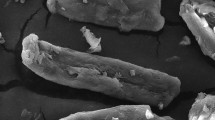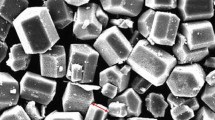Abstract
Cellulose ethers (CE) are introduced in almost all cement-based dry mortars in order to retain water in mortar mass avoiding losing it too quickly by substrate absorption or water evaporation. In this way the workability of the fresh material, the adherence to the substrate and internal-strength characteristics of mortar, render or tile adhesive are improved. One of the side effects of cellulose ethers is the Portland cement hydration delaying. The influence of six commercial cellulose ethers, hydroxyethylmethyl cellulose (HEMC) type, on the hydration of Portland cement CEM I 42.5 R, was followed by thermal analysis (TG and DTA curves). Three of these cellulose ethers are unmodified, and have different viscosities, while three of them have the same viscosity but differ in the degree of modification (unmodified, one with medium modification and one with high modification). The interest of dry mortars producers for the effects of these cellulose ethers, is generated by the wide offer available on the market and by the absence of systematic data on the effect of different viscosities and degrees of modification on dry mortars properties. In order to quantify the effect of the CE on the cement hydration, the surface area of the endothermic effect corresponding to the dehydration of portlandite (Ca(OH)2), formed after 1, 3, and 7 days of hydration, was defined. It was noted that the proportion of Ca(OH)2 in samples containing CE after 1 day was 30–40 % lower than in reference sample. After 3 and 7 days of hydration the proportion of Ca(OH)2 in samples containing CE approaches that of reference sample (10–20 % less). For the same period of hydration, the different viscosity, and different degree of modification of cellulose ethers cause variations in narrow limits of the proportion of Ca(OH)2, and the degree of cement hydration, respectively.





Similar content being viewed by others
References
Pourchez J, Peschard A, Grosseau P, Guyonnet R, Guilhot B, Vallée F. HPMC and HEMC influence on cement hydration. Cem Concr Res. 2006;36:288–94.
Pourchez J, Grosseau P, Ruot B. Current understanding of cellulose ethers impact on the hydration of C3A and C3A-sulphate systems. Cem Concr Res. 2009;39:664–9.
Betioli AM, Gleize PJP, Silva DA, John VM, Pileggi RG. Effect of HMEC on the consolidation of cement pastes: isothermal calorimetry versus oscillatory rheometry. Cem Concr Res. 2009;39:440–5.
Baoguo MA, Zhihua OU, Shouwei Jian, Rulin XU. Influence of cellulose ethers on hydration products of Portland cement. J Wuhan University Technol-Mater Sci Ed. 2011;26:588–93.
Patural L, Grosseau P, Govin A, Pourchez J, Ruot B, Water transport in freshly-mixed mortars containing cellulose ethers, Journal du CEREM 2008, emse-00517893.
Patural L, Govin A, Grosseau P, Ruot B, Devès O, Influence of cellulose ether particle size on water retention of freshly-mixed mortars, Journal du CEREM 2009, HAL-00457932.
Patural L, Porion P, Van Damme H, Govin A, Grosseau P, Ruot B, Devès O. A pulsed field gradient and NMR imaging investigations of the water retention mechanism by cellulose ethers in mortars. Cem Concr Res. 2010;40:1378–85.
Patural L, Marchal P, Govin A, Grosseau P, Ruot B, Devès O. Cellulose ethers influence on water retention and consistency in cement-based mortars. Cem Concr Res. 2011;41:46–55.
Pourchez J, Govin A, Grosseau P, Guyonnet R, Guilhot B, Ruot B. Alkaline stability of cellulose ethers and impact of their degradation products on cement hydration. Cem Concr Res. 2006;36:1252–6.
Pourchez J, Grosseau P, Guyonnet R, Ruot B. HEC influence on cement hydration measured by conductometry. Cem Concr Res. 2006;36:1777–80.
Pourchez J, Grosseau P, Ruot B. Changes in C3S hydration in the presence of cellulose ethers. Cem Concr Res. 2010;40:179–88.
Patural L, Govin A, Grosseau P, Ruot B, Devès O, The effect of cellulose ethers on water retention in freshly-mixed mortars, Proceedings of the 11th ECERS Conference, Krakow, 2009.
Silva DA, Roman HR, John VM, Effects of EVA and HEC polymers on the Portland cement hydration, Proceeding of the 11th International Congress on Polymers in Concrete 2004, 91–7.
Jolicoeur C, Simard MA. Chemical admixture-cement interactions: phenomenology and physico-chemical concepts. Cem Concr Compos. 1998;20:87–101.
Lazău I, Păcurariu C, Ciobanu C. The use of thermal analysis to investigate the effects of cellulose ethers on the Portland cement hydration. J Therm Anal Calorim. 2011;. doi:10.1007/s10973-011-2091-7.
Ciobanu C, Iluc S, Lazău I, Păcurariu C. Some physico-mechanical properties of dry mortars containing cellulose ethers. Romanian J Mater. 2011;41:30–41.
SR EN 1015-11:2002/A1:2007, Methods of test for mortar for masonry. Part 11: Determination of flexural and compressive strength of hardened mortar.
Menéndez E, Andrade C, Vega L. Study of dehydration and rehydration processes of portlandite in mature and young cement pastes. J Therm Anal Calorim. 2012;. doi:10.1007/s10973-011-2167-4.
Goñi S, Puertas F, Hernández MS, Palacios M, Guerrero A, Dolado JS, Zanga B, Baroni F. Quantitative study of hydration of C3S and C2S by thermal analysis. Evolution and composition of C–S–H gels formed. J Therm Anal Calorim. 2010;102:965–73.
Kontori E, Perraki T, Tsivilis S, Kakali G. Zeolite blended cements: evaluation of their hydration rate by means of thermal analysis. J Therm Anal Calorim. 2009;96:993–8.
Chaipanich A, Nochaiya T. Thermal analysis and microstructure of Portland cement–fly ash–silica fume pastes. J Therm Anal Calorim. 2010;99:487–93.
Pacewska B, Blonkowski G, Wilińska I. Investigations of the influence of different fly ashes on cement hydration. J Therm Anal Calorim. 2006;86:179–86.
Neves A Jr, Filho RDT, Fairbairn EMR, Dweck J. Early stages hydration of high initial strength Portland cement. Part I. Thermogravimetric analysis on calcined mass basis. J Therm Anal Calorim. 2012;108:725–31.
Knapen E, Van Gemert D. Cement hydration and microstructure formation in the presence of water-soluble polymers. Cem Concr Res. 2009;39:6–13.
Dweck J, Buchler PM, Cartledge FK. The effect of different bentonites on cement hydration during solidification/stabilization of tannery wastes. J Therm Anal Calorim. 2001;64:1011–6.
Bakolas A, Aggelakopoulou E, Moropoulou A, Anagnostopoulou S. Evaluation of pozzolanic activity and physico-mechanical characteristics in metakaolin-lime pastes. J Therm Anal Calorim. 2006;84:157–63.
Kuliffayová M, Krajči L, Janotka I, Šmatko V. Thermal behaviour and characterization of cement composites with burnt kaolin sand. J Therm Anal Calorim. 2012;108:425–32.
Stepkowska ET. Simultaneous IR/TG study of calcium carbonate in two aged cement pastes. J Therm Anal Calorim. 2006;84:175–80.
Stepkowska ET, Blanes JM, Real C, Perez-Rodriguez JL. Hydration products in two aged cement pastes. J Therm Anal Calorim. 2005;82:731–9.
SR EN 1015-3:2001/A2:2007, Methods of test for mortar for masonry. Part 3: Determination of consistence of fresh mortar (by flow table).
Acknowledgements
This study was partially supported by the strategic grant POSDRU/88/1.5/S/50783, Project ID50783 (2009), co-financed by the European Social Fund—Investing in People, within the Sectoral Operational Programme Human Resources Development 2007–2013.
Author information
Authors and Affiliations
Corresponding author
Electronic supplementary material
Below is the link to the electronic supplementary material.
Rights and permissions
About this article
Cite this article
Ciobanu, C., Lazǎu, I. & Pǎcurariu, C. Investigation of the cellulose ethers effect on the Portland cement hydration by thermal analysis. J Therm Anal Calorim 112, 325–330 (2013). https://doi.org/10.1007/s10973-012-2789-1
Published:
Issue Date:
DOI: https://doi.org/10.1007/s10973-012-2789-1




